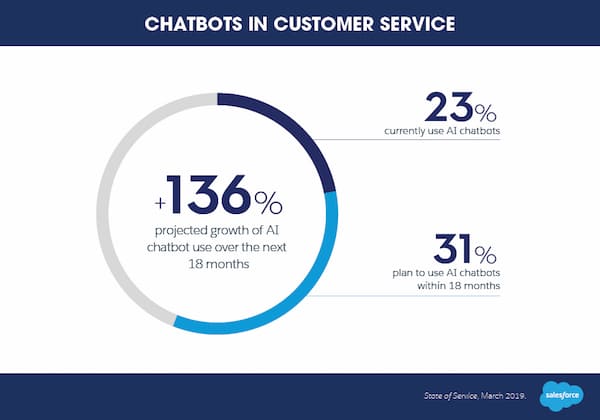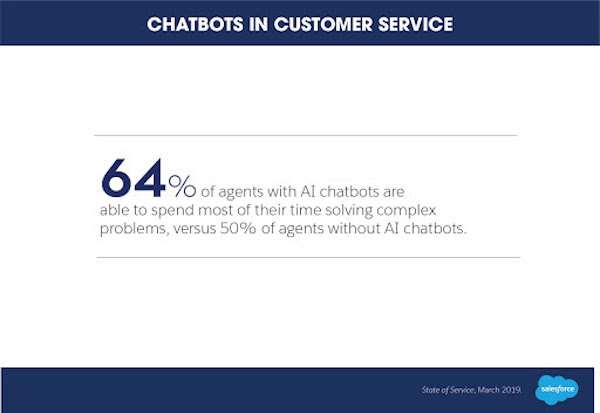Customer experience expectations are on an upward trajectory, and the stakes are high for companies. In 2019, 84% of customers said the experience a company provides is as important as its products and services — up from 80% in 2018.
Standing at the doorstep of the new decade, let’s examine where these changes will take companies and their customers. Here is a look through several years of Salesforce’s original research to examine one of our favorite topics: what will be the 2020 CRM trends?
Marketers hone in on the customer identity problem
Armed with the power of artificial intelligence, the Internet of Things, and more, marketers can interact in meaningful, personal ways with millions — even billions — of customers, all in real-time. However, creating and iterating on competitive marketing programs depends on large amounts of data — and robust management and analysis capabilities. In the most recent State of Marketing report, we forecast that the median number of customer data sources used by marketers globally, would jump 50% from 10 in 2017 to 15 in 2019 — and we see no signs this trend will slow.
Already, less than half of marketers have a complete, unified view of customer data sources. As the number of data sources climbs, we anticipate that marketers will need to adapt their infrastructure to accommodate the increasing complexities of managing that data and drawing insights from it.
Survey data from the same study shows the average business uses three different technologies for customer identity purposes. These may often be owned by different departments, handling specific parts of the customer journey — for instance, sales activity managed in a CRM, advertising managed by a data management platform (DMP), and so on. Will 2020, and the early years of the new decade, finally be the era marketers simplify and modernize their technology stack?
While there are several ways to resolve customer identity, there isn’t yet universal adoption of a single solution. However, we anticipate investment and innovation on this problem to increase, given only 28% of marketers are completely satisfied with their ability to create a shared, single view of customers across business units.
Shopping moves to the edge
The past decade saw frequent headlines of a “retail apocalypse.” But the reality is that retail is far from dead — it’s just transformed, in what some view as a renaissance. We anticipate the commerce journey in the coming years to encompass an increasing number of touchpoints as it becomes embedded in our everyday lives.
The key commerce trend we anticipate is “shopping at the edge” of traditional spheres — i.e., on emerging digital purchase points like voice, social media, or even gaming consoles, beyond retailers’ and brands’ owned physical and digital properties. No need to run to the store; the store will come to you in the apps and platforms you use every day, blurring the very definition of shopping.
Already in 2019, nearly one in 10 purchases occur on channels separate from retailers’ and brands’ owned physical and digital properties. These channels are particularly attractive to younger generations. We found, for instance, that Gen Zers are more than three times as likely as silents and baby boomers to use emerging digital purchase points, and that one in four millennials and Gen Zers are interested in shopping with gaming consoles. As younger generations gain a greater share of purchasing power, and as innovation continues in the space, we predict shopping will move closer and closer to the edge.
Voice technology revolutionizes the sales process
Over the past few years, sales has gone increasingly virtual. However, while virtual meetings cut down on transit time, administrative tasks like data entry and quote generation remain massive time sinks. Shockingly, our State of Sales research found sales reps spending just 34% of their time actually selling.

Voice-enabled mobile apps for sales may be the answer. We already have the technology: speech recognition can reliably log calls, and natural language processing can spot key phrases in a transcript, generating call summaries and triggering automated tasks like scheduling meetings, creating opportunities, and flagging competitor mentions.
Sixty-eight percent of IT leaders believe voice technologies will be a key part of their company’s business processes by 2021. We agree. If people can rely on smart speakers and voice assistants to manage many aspects of their personal lives, why wouldn’t that expand into sales relationships? We anticipate voice technology to take sales by storm in the coming decade.
Customer service agents take on elevated mandates
Mounting customer expectations make service a challenging field. For instance, 71% of customers expect companies to communicate with them in real time, and 40% won’t do business with a company if they can’t use their preferred communication channels.
To meet these demands, we anticipate customer service to radically transform, with companies using artificial intelligence (AI) to manage simple/repetitive tasks, while investing in training to advance agents to a more strategic role.
The changes will be rapid. Based on the responses of over 3,500 service agents and decision-makers surveyed, AI-powered chatbots will more than double over an 18-month period.

Provide self-service in simple scenarios
Gather initial information about a service case before handing off to an agent
Provide agents with guidance and recommendations as they handle cases
Greet customers when they call
That is to say, human agents aren’t going anywhere. Eighty-five percent of service decision-makers view investment in agents as a vital part of service transformation. Over the coming years, the biggest change in service organizations will be the distribution of work, with artificial intelligence freeing agents to deliver value in cases that are complex and involved.

In the coming years, marketing, sales, commerce, and service will focus on connecting with the customer across new channels and blurring the lines between departments. However, departments will not be able to meet goals by optimizing operations in isolation. Nearly eight in 10 customers also expect consistent interactions across departments, making the mission a full-company endeavor.
We believe the next decade will be characterized by a race towards system integration. Successful companies will empower IT to move customer-facing teams onto integrated platforms, fostering a single view of the customer across all interactions.
Fortunately, IT is on the same page. Eighty-three percent of IT leaders say data silos create business challenges, and 97% are currently undertaking or planning to undertake digital transformation initiatives to improve customer experience. We believe IT teams like Decathlon’s point the way to the future. By using reusable APIs and integrations to make it easy to plug in new services, they drive seamless customer experiences at scale.
Learn more
Check out 2020 predictions from our executives on topics like customer engagement, artificial intelligence, and the future of work.
Or, explore Salesforce Research’s most popular reports, covering trends in:
Customer experience
Marketing
Commerce
Sales
Service
Enterprise technology



